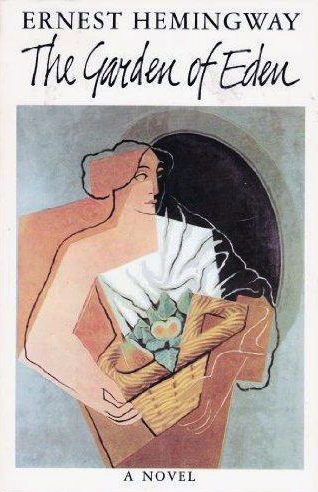Juan Gris’s Woman with a Basket is the dust jacket for the 1st edition of The Garden of Eden. Gris was among Hemingway’s favorite painters, and Patrick Hemingway thought this work expressed his father’s narrative’s “somber hedonism.” The woman’s basket is suggestive of a picnic of which there are two—the first unpleasant and the second happy.
They are critical moments in the novel, and for Hemingway, each picnic describes a new twist in the story of David Bourne, a blocked writer suffering a destructive marriage three weeks old. Contrasting the picnics, you can see how Boerne’s emotional life rocks between suffused love/anger with Catherine Hill and lust for Marita, a sybaritic young woman Catherine picks up as a sex toy.
David’s first picnic is unhappily undermined by sexual uneasiness because Catherine has requested that David no longer be her “man” but her “girl.” David is perplexed and tries to evade an answer. Catherine gets petulant, but instead of discussing her needs, she complains about the picnic: the wind is too strong, and the situation is uncomfortable. She looks for another location: “We could have gone up there,” she says, “But it’s so closed in and picturesque. I hate those hanging villages.” However, the food is good, and there is silence (at least) while they eat stuffed eggs, roast chicken, pickles, and a baguette of bread slathered with Savora mustard—and drink a (seemingly) inexhaustible supply of cold rosé. But when they are finished, Catherine’s argumentative conversation resumes until David says, “Let’s clean up and go.” “Where?” she says, “Anywhere,” he replies, “The goddamn café.”
David’s picnic with Marita is happier. For the moment, David’s irony is reassuring. Besides, the day is perfect, and the beach at Juan-les-Pins is an Impressionist’s dream of bright sunshine, a dark blue sea, red rocks, and yellow sand that turns amber covered by the creamy surf. He’s also separated from Catherine, and his passion is ignited by Marita, Catherine’s lover but now his. In a sexual tug-of-war, David wins. And when Marita asks if they are now the Bournes, David replies, “Sure. We are the Bournes.” For emphasis, he says, “I’ll write it in the sand.”
Curiously the food at this beach picnic is leaner and vegetarian: crisp radishes, green artichoke hearts with mustard sauce, and bottles of Tavel rosé.
*Featured Image: John Irvin. The Garden of Eden (2008). The screenplay by James Scott Linville is based on Ernest Hemingway’s novel (1986). David Bourne (Jack Huston) ponders Catherine’s sexuality and his own. But this is an outing at the beach, not what Hemingway writes about. No food, no wine, no picnic.
See Ernest Hemingway. The Garden of Eden. New York: Charles Scribner’s Sons, 1986; John Irvin. The Garden of Eden (2008). Screenplay by James Scott Linville is based on Ernest Hemingway’s novel (1986); Craig Boreth. The Hemingway Cookbook. Chicago: Chicago Review Press, 1998, 2012; Tom Jenks. “The Garden of Eden at Twenty-Five,” Huffington Post Books. July 29, 2011.

